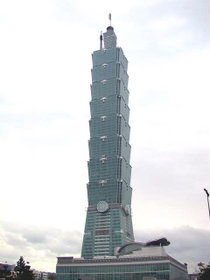By Glenn Rigby
Taipei is the capital of Taiwan, an island off the coast of the People's Republic of China. It is rife with culture and historical importance. There are many fascinating temples, museums, towers and other architectural features.
Let's take a look at some popular sightseeing spots, shall we?
* Taipei 101 – The world's tallest building when built in 2004. The design is inspired by traditional Chinese architecture, with a shape resembling a pagoda. The sectioned tower is also inspired by the bamboo plant, which is a model of strength, resilience, and elegance.

* Chiang Kai-shek Memorial Hall – A majestic marble monument surrounded by gardens and ponds, the Memorial contains a statue of late President Chiang Kai-shek. A ground-level library displays photos and mementos of the late president's life. Adjoining the Memorial are the National Theater and National Concert Hall, both built in a traditional Chinese palace style.
Changing of the Guards: every hour.

* National Palace Museum – The National Palace Museum was established in Beijing on October 10, 1925, shortly after the expulsion of Puyi, the last emperor of China, from the Forbidden City by warlord Feng Yü-hsiang. The articles in the museum consisted of the valuables of the former Imperial family and were moved from place to place in the 1930s and 1940s to prevent them from falling into the hands of the invading Imperial Japanese Army.

* Confuscius Temple – In contrast to many other temples, the Confucius Temple is a tranquil place that comes to life only at dawn on September 28. On this day every year rites are performed, some of which date back nearly 3,000 years, by school children in ancient costume to honor Confucius on his birthday.
* Pao An Temple – A short walk from the Confucius Temple is the 230-year-old Taoist Pao An Temple. The three main deities worshipped here are Pao Sheng, God of Medicine; Ju Lai Fo, God of Luck; and Chu Sheng Niang Niang, Goddess of Birth and Fertility.
* Martyrs Shrine – An excellent example of classical Ming dynasty architecture, dedicated to the fallen heroes of China's wars. A majestic archway, tranquil paths, and a ceremonial changing of the guards. Changing of the Guards: every hour, 10 minutes to the hour.



 ShareThis
ShareThis
